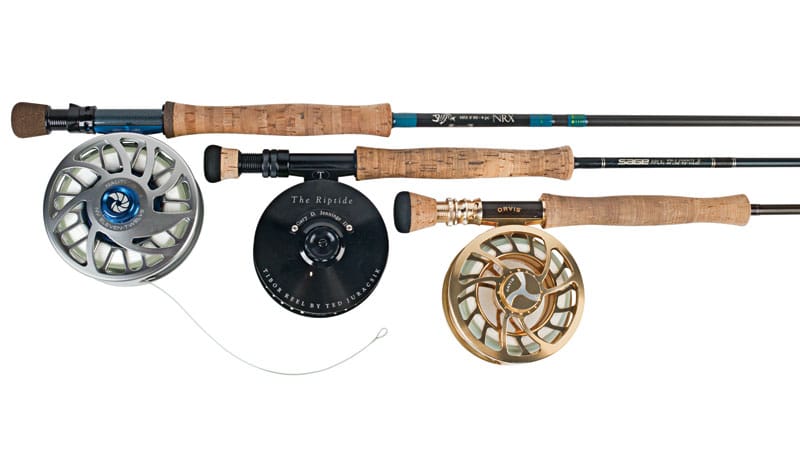
fly rod setup
Is there one fly-rod/fly-line combination that could cover the different saltwater fly-fishing conditions around the world?
Well, if I were trapped on an island and needed to feed myself, a 12-weight 9-foot Equalizer would be my choice. It’s a Scientific Anglers fiberglass rod that was designed by Lefty Kreh in the late ’60s — it is unbreakable. It’s a heavy rod built to fight big fish, not for general fly-fishing, especially by today’s standards, but that rod would put food on the table and never fail. However, if I wanted to have fun and fish effectively for many different species in a number of water types, another setup would work for most scenarios.
A 9-foot 9-weight rod with a clear inter-mediate fly line is perhaps the best outfit for a variety of fishing environments. This setup covers most situations from Maine to Texas, plus along the West Coast and in a good number of locations abroad. And there is no question that this combination is the workhorse of the Northeast saltwater angler.
Will it work for all species and conditions? No. But if I could have only one line/rod combo to fish, this would be my choice.
Surf Advantages
For fishing light to moderate surf along open beaches, this combo will suffice most of the time. Snook, stripers and redfish roam the first wave and feed from right in the white water to just beyond. This fishing requires swimming the fly so it swings with the flow off the beach into the drop-off. Fishing the slot just out from the first bar is the key to success. You are blind-casting mostly, unless the surf is very light and the water is clear. You might see fish cruising that edge, but you will seldom see a fish take the fly unless the fish follows it out of the trough. The hot strike zone is the gully right off the beach, usually three to eight feet deep — the intermediate line will keep the fly right in that holding water. School-feeding fish like bonito, false albacore, jacks and bluefish drive bait right into the beach. Most 9-weight rods have enough punch to buck the wind and get the fly to the fish. And an intermediate line allows for quick casts if these fish are popping up and down, leaving little time to present the fly.
Sight-Fishing Potential
This combination is also effective when sight-casting in deeper water. When you are fishing an edge or a gully in a location with a strong flow, getting the fly down quickly is essential. Many of the deeper flats in the Northeast require reaching the bottom in a hurry. When you’re fishing a strong flow in the wind, getting the fly to settle down to the fish’s level can be difficult. Not only does an intermediate line cut through the wind better when cast, but it evades the wind effectively once it drops below the surface. I have even used one when fishing on three- to four-foot-deep flats for bonefish for the same reason. A fly that drags along the bottom from the wind’s effect does not look natural to a wary bonefish, so unless the bonefish are uneducated, you need to get the fly to settle. In tough conditions, try letting the line rest on the bottom and then using short pulls to hop the fly like a shrimp or crab trying to find cover. It’s not the kind of bonefishing I like to do, but when bad weather hits and time is limited, it can salvage the day, or trip.
Abilities Abroad
In many places around the world, this outfit is a go-to. For the 5- to 40-pound school-size tarpon and snook found in many parts of Mexico’s Yucatan Peninsula, a 9-weight setup is perfect. This type of fishing requires casting for hours upon hours, trying to get the fly into the small pockets of water around the mangroves. The 9-weight isn’t overkill for these fish, yet it’s light enough to cast all day. I found another use for this rod/line combo in the Yucatan when fishing for bonefish in the surf. There are sections of beach where bonefish feed in the first wave. This was a first for me, and it gave me an even greater appreciation of the versatility this basic tackle setup offers.
Anglers who travel are sometimes restricted to the number of outfits that can fit into luggage. Of course, we would all like to have an arsenal of different-size rods and reels to bring everywhere we go. But when space is limited, the first two rods I pack are 9-foot 9-weights, with at least one reel spooled with an intermediate line. And when I walk a beach for the first time, no matter where it is, I carry the same. Rarely do I need anything else.
Surface Options
For chasing fast-moving surface-feeding fish in a boat, this combo of an intermediate line and a 9-foot 9-weight rod is ideal. The stick casts quickly and has enough beef for fighting fish in the 15- to 20-pound range, and in the hands of a skilled angler, it can take much bigger fish. It’s a favorite-size rod for guides because many anglers can cast it well and, when a client is covering large sections of water blind-casting, it’s not too demanding to fish all day.
Although this setup might not be the very best popper outfit, in a pinch you can fish a surface bug. The key to fishing a popper with an intermediate line is starting the retrieve as soon as the line hits the water. This will slow the line’s descent and keep the popper on the surface, but you must use a faster retrieve and keep the bug moving. Use a 9-foot tapered leader and a good-size high-density foam popper for the best results.









